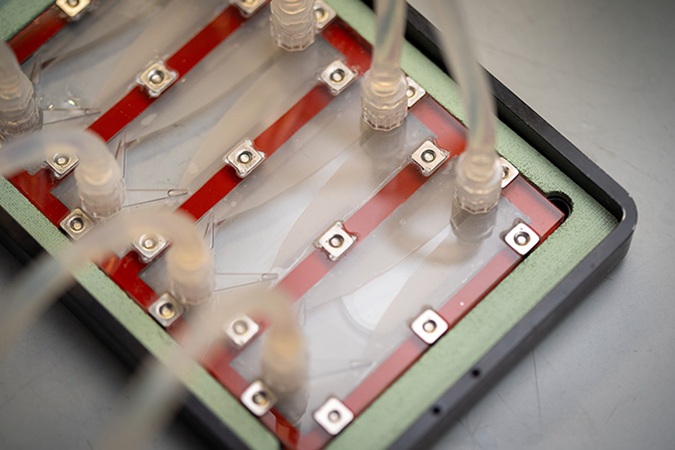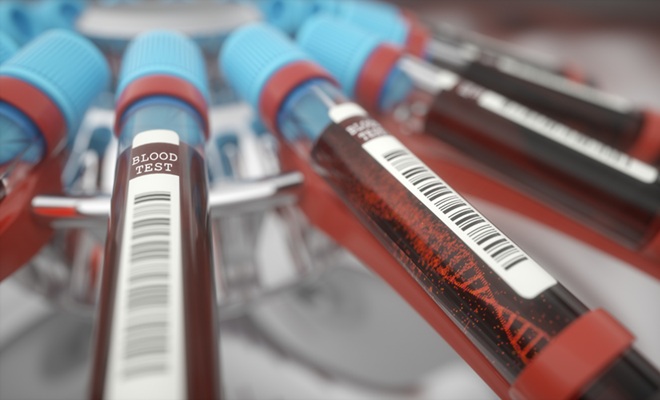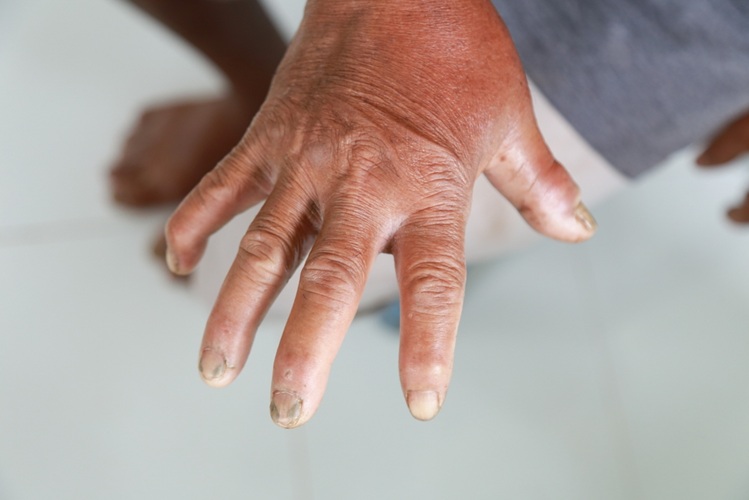Microfluidic Device Assesses Stickiness of Tumor Cells to Predict Cancer Spread
|
By LabMedica International staff writers Posted on 06 Mar 2025 |

Ductal carcinoma in situ (DCIS), a type of early-stage breast cancer, is often referred to as stage zero breast cancer. In many cases, it remains harmless and does not spread beyond the milk ducts where it originates. However, in some instances, DCIS progresses into invasive breast cancer, which can become life-threatening. Despite years of research, determining which cases require aggressive treatment and which can be safely monitored has remained difficult. Clinical decisions about treatment usually depend on the size and grade of the DCIS lesion, but these factors do not always reliably predict the behavior of the cancer. Identifying a better way to predict which cases are likely to become more aggressive could significantly enhance treatment strategies. Now, researchers have discovered a potential method for predicting the likelihood of cancer spreading by assessing the "stickiness" of tumor cells. This breakthrough, made possible by a specially designed microfluidic device, could help doctors identify high-risk patients and tailor their treatment plans more effectively.
The innovative device, developed by scientists at the University of California San Diego (La Jolla, CA, USA), works by pushing tumor cells through fluid-filled chambers and sorting them based on how well they adhere to the walls of the chambers. In tests with tumor cells collected from patients with various stages of breast cancer, the researchers identified a distinct pattern: cells from patients with more aggressive cancers were less sticky (weakly adherent), while cells from patients with less aggressive cancers were more sticky (strongly adherent). The team’s previous research had already shown that cancer cells with weak adhesion are more likely to migrate and invade surrounding tissues, compared to cells with stronger adhesion. By testing this concept on patient tumor samples, the team advanced their work, demonstrating that the adhesion strength of tumor cells varies and that this characteristic might help predict whether a patient’s cancer will spread.
The device, about the size of an index card, consists of microfluidic chambers that are coated with adhesive proteins found in breast tissue, like fibronectin. When tumor cells are introduced into the chambers, they adhere to the fibronectin coating. The cells are then subjected to increasing shear stress as fluid flows through the chambers. By observing where cells detach under specific stress levels, the researchers categorize them as weakly or strongly adherent. In their most recent study, the team used this device to examine cell adhesion in DCIS samples. The device was tested in an investigator-initiated trial with samples from 16 patients, including normal breast tissue, DCIS tumors, and aggressive breast cancer tumors from patients with invasive ductal and lobular carcinomas. The results, published in Cell Reports, revealed that aggressive breast cancer samples contained weakly adherent cells, while normal breast tissue samples contained strongly adherent cells. DCIS samples showed intermediate levels of adhesion, but there was significant variability across patients. Moving forward, the team plans to monitor DCIS patients over the next five years to assess whether adhesion strength correlates with metastatic progression. If their hypothesis proves correct, this device could provide oncologists with a powerful tool to inform treatment decisions, potentially recommending more aggressive treatments for patients with tumors showing weak cell adhesion.
“Right now, we don’t have a reliable way to identify which DCIS patients are at risk of developing more aggressive breast cancer. Our device could change that,” said study senior author Adam Engler, a professor in the Shu Chien-Gene Lay Department of Bioengineering at the UC San Diego Jacobs School of Engineering. “Our hope is that this device will allow us to prospectively identify those at highest risk, so that we can intervene before metastasis occurs.”
Latest Pathology News
- New Error-Corrected Method to Help Detect Cancer from Blood Samples Alone
- "Metal Detector" Algorithm Hunts Down Vulnerable Tumors
- Novel Technique Uses ‘Sugar’ Signatures to Identify and Classify Pancreatic Cancer Cell Subtypes
- Advanced Imaging Reveals Mechanisms Causing Autoimmune Disease
- AI Model Effectively Predicts Patient Outcomes in Common Lung Cancer Type
- AI Model Predicts Patient Response to Bladder Cancer Treatment
- New Laser-Based Method to Accelerate Cancer Diagnosis
- New AI Model Predicts Gene Variants’ Effects on Specific Diseases
- Powerful AI Tool Diagnoses Coeliac Disease from Biopsy Images with Over 97% Accuracy
- Pre-Analytical Conditions Influence Cell-Free MicroRNA Stability in Blood Plasma Samples
- 3D Cell Culture System Could Revolutionize Cancer Diagnostics
- Painless Technique Measures Glucose Concentrations in Solution and Tissue Via Sound Waves
- Skin-Based Test to Improve Diagnosis of Rare, Debilitating Neurodegenerative Disease
- Serum Uromodulin Could Indicate Acute Kidney Injury in COVID-19 Patients
- AI Model Reveals True Biological Age From Five Drops of Blood
- First-Of-Its-Kind AI Tool Visualizes Cell’s ‘Social Network’ To Treat Cancer
Channels
Clinical Chemistry
view channel
New Method Uses Pulsed Infrared Light to Find Cancer's 'Fingerprints' In Blood Plasma
Cancer diagnoses have traditionally relied on invasive or time-consuming procedures like tissue biopsies. Now, new research published in ACS Central Science introduces a method that utilizes pulsed infrared... Read more
Carbon Nanotubes Help Build Highly Accurate Sensors for Continuous Health Monitoring
Current sensors can measure various health indicators, such as blood glucose levels, in the body. However, there is a need to develop more accurate and sensitive sensor materials that can detect lower... Read moreMolecular Diagnostics
view channel
Gene-Based Blood Test Accurately Predicts Tumor Recurrence of Advanced Skin Cancer
Melanoma, an aggressive form of skin cancer, becomes extremely difficult to treat once it spreads to other parts of the body. For patients with metastatic melanoma tumors that cannot be surgically removed... Read more
Blood Test Could Identify Patients at Risk for Severe Scleroderma
Systemic sclerosis, also known as scleroderma, causes the hardening of the skin and connective tissues. In many cases, the disease can also damage vital organs, including the heart, kidneys, lungs, and... Read moreHematology
view channel
New Scoring System Predicts Risk of Developing Cancer from Common Blood Disorder
Clonal cytopenia of undetermined significance (CCUS) is a blood disorder commonly found in older adults, characterized by mutations in blood cells and a low blood count, but without any obvious cause or... Read more
Non-Invasive Prenatal Test for Fetal RhD Status Demonstrates 100% Accuracy
In the United States, approximately 15% of pregnant individuals are RhD-negative. However, in about 40% of these cases, the fetus is also RhD-negative, making the administration of RhoGAM unnecessary.... Read moreImmunology
view channel
Stem Cell Test Predicts Treatment Outcome for Patients with Platinum-Resistant Ovarian Cancer
Epithelial ovarian cancer frequently responds to chemotherapy initially, but eventually, the tumor develops resistance to the therapy, leading to regrowth. This resistance is partially due to the activation... Read more
Machine Learning-Enabled Blood Test Predicts Immunotherapy Response in Lymphoma Patients
Chimeric antigen receptor (CAR) T-cell therapy has emerged as one of the most promising recent developments in the treatment of blood cancers. However, over half of non-Hodgkin lymphoma (NHL) patients... Read moreMicrobiology
view channel
Handheld Device Delivers Low-Cost TB Results in Less Than One Hour
Tuberculosis (TB) remains the deadliest infectious disease globally, affecting an estimated 10 million people annually. In 2021, about 4.2 million TB cases went undiagnosed or unreported, mainly due to... Read more
New AI-Based Method Improves Diagnosis of Drug-Resistant Infections
Drug-resistant infections, particularly those caused by deadly bacteria like tuberculosis and staphylococcus, are rapidly emerging as a global health emergency. These infections are more difficult to treat,... Read more
Breakthrough Diagnostic Technology Identifies Bacterial Infections with Almost 100% Accuracy within Three Hours
Rapid and precise identification of pathogenic microbes in patient samples is essential for the effective treatment of acute infectious diseases, such as sepsis. The fluorescence in situ hybridization... Read moreTechnology
view channel
Pain-On-A-Chip Microfluidic Device Determines Types of Chronic Pain from Blood Samples
Chronic pain is a widespread condition that remains difficult to manage, and existing clinical methods for its treatment rely largely on self-reporting, which can be subjective and especially problematic... Read more
Innovative, Label-Free Ratiometric Fluorosensor Enables More Sensitive Viral RNA Detection
Viruses present a major global health risk, as demonstrated by recent pandemics, making early detection and identification essential for preventing new outbreaks. While traditional detection methods are... Read moreIndustry
view channel
Cepheid and Oxford Nanopore Technologies Partner on Advancing Automated Sequencing-Based Solutions
Cepheid (Sunnyvale, CA, USA), a leading molecular diagnostics company, and Oxford Nanopore Technologies (Oxford, UK), the company behind a new generation of sequencing-based molecular analysis technologies,... Read more
Grifols and Tecan’s IBL Collaborate on Advanced Biomarker Panels
Grifols (Barcelona, Spain), one of the world’s leading producers of plasma-derived medicines and innovative diagnostic solutions, is expanding its offer in clinical diagnostics through a strategic partnership... Read more























